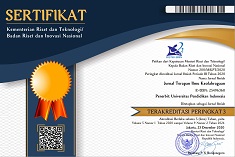Efektivitas Latihan Imajeri Mental dalam Penguasaan Lob Bertahan dalam Permainan Bulutangkis
Abstract
Keywords
References
Agustan, B., Kusmaedi, N., Hendrayana, Y., Abduljabar, B., & Ginanjar, A. (2020). Modifikasi pembelajaran: hybrid sport education-invasion games competence model terhadap performa permainan bola basket. Jurnal SPORTIF : Jurnal Penelitian Pembelajaran, 6(1), 157–172. https://doi.org/10.29407/js_unpgri.v6i1.14005
Agustin, A. dan S. (2019). LLT Journal: A Journal on Language and Language Teaching. LLT Journal: A Journal on Language and Language Teaching, 22(1), 46–57.
Agustin, A., & Susilowaty, S. (2019). STUDENTS’PERCEPTION OF TABLEAU IN EFL CLASSROOM. LLT Journal: A Journal on Language and Language Teaching, 22(2), 209–230.
Anderson-Cook, C. M. (2005). Experimental and Quasi-Experimental Designs for Generalized Causal Inference. Journal of the American Statistical Association, 100(470), 708–708. https://doi.org/10.1198/jasa.2005.s22
Di Corrado, D., Guarnera, M., Guerrera, C. S., Maldonato, N. M., Di Nuovo, S., Castellano, S., & Coco, M. (2020). Mental Imagery Skills in Competitive Young Athletes and Non-athletes. Frontiers in Psychology, 11(April), 1–7. https://doi.org/10.3389/fpsyg.2020.00633
Filgona, J., Sakiyo, J., Gwany, D. M., & Okoronka, A. U. (2020). Motivation in Learning. Asian Journal of Education and Social Studies, 10(4), 16–37. https://doi.org/10.9734/ajess/2020/v10i430273
Floridou, G. A., Peerdeman, K. J., & Schaefer, R. S. (2022). Individual differences in mental imagery in different modalities and levels of intentionality. Memory and Cognition, 50(1), 29–44. https://doi.org/10.3758/s13421-021-01209-7
Hecker, J. E., & Kaczor, L. M. (2016). Application of Imagery Theory to Sport Psychology: Some Preliminary Findings. Journal of Sport and Exercise Psychology, 10(4), 363–373. https://doi.org/10.1123/jsep.10.4.363
Hidayat, Y. (2016). The analysis of mental imagery functions in badminton for novice athletes. Ijcta, 9(35), 191–205.
Hidayat, Y., Komarudin, & Martini, T. (2021). Mental imagery applicative model for beginner badminton coaches. International Journal of Human Movement and Sports Sciences, 9(4), 59–65. https://doi.org/10.13189/saj.2021.091310
Hidayat, Y., Yudiana, Y., Hambali, B., & Nugraha, R. (2022). Reliability and Factorial Validity of Badminton Basic Skill among Badminton Beginner Athletes: A Preliminary Study. International Journal of Human Movement and Sports Sciences, 10(5), 922–931. https://doi.org/10.13189/saj.2022.100508
Hidayat, Y., Yudiana, Y., Hambali, B., Sultoni, K., Ustun, U. D., & Singnoy, C. (2023). The effect of the combined self-talk and mental imagery program on the badminton motor skills and self-confidence of youth beginner student-athletes. BMC Psychology, 11(1), 1–16. https://doi.org/10.1186/s40359-023-01073-x
Kamalov, F., Santandreu Calonge, D., & Gurrib, I. (2023). New Era of Artificial Intelligence in Education: Towards a Sustainable Multifaceted Revolution. Sustainability (Switzerland), 15(16), 1–27. https://doi.org/10.3390/su151612451
Kim, T., Frank, C., & Schack, T. (2017). A systematic investigation of the effect of action observation training and motor imagery training on the development of mental representation structure and skill performance. Frontiers in Human Neuroscience, 11(October), 1–13. https://doi.org/10.3389/fnhum.2017.00499
Kurniawan, T. (2022). Effects of Mental Fatigue on Visual Scanning Speed in First-Person Shooter Esports Athletes. ASEAN Journal for Sport Development and Peace, 2(1), 57–63.
Lang, P. J. (1977). Imagery in therapy: an information processing analysis of fear. Behavior Therapy, 8(5), 862–886. https://doi.org/10.1016/S0005-7894(77)80157-3
Li, T., & Li, Q. (2024). Virtual Reality in Historic Urban District Renovation for Enhancing Social and Environmental Sustainability: A Case of Tangzixiang in Anhui. Sustainability (Switzerland) , 16(7). https://doi.org/10.3390/su16072665
Mak, M., De Vries, C., & Willems, R. M. (2020). The Influence of Mental Imagery Instructions and Personality Characteristics on Reading Experiences. Collabra: Psychology, 6(1), 1–24. https://doi.org/10.1525/collabra.281
Marks, D. F. (2023). Phenomenological Studies of Visual Mental Imagery: A Review and Synthesis of Historical Datasets. Vision (Switzerland), 7(4). https://doi.org/10.3390/vision7040067
Maydeu-Olivares, A., & Millsap, R. E. (2009). The SAGE handbook of quantitative methods in psychology.
Mitić, P., Nedeljković, J., Takšić, V., Sporiš, G., Stojiljković, N., & Milčić, L. (2020). Sports performance as a moderator of the relationship between coping strategy and emotional intelligence. Kinesiology, 52(2), 281–289. https://doi.org/10.26582/k.52.2.15
O.Nyumba, T., Wilson, K., Derrick, C. J., & Mukherjee, N. (2018). The use of focus group discussion methodology: Insights from two decades of application in conservation. Methods in Ecology and Evolution, 9(1), 20–32. https://doi.org/10.1111/2041-210X.12860
Oktavia, G. N., & Kurniawan, T. (2022). Analisis Monitoring Wellness dengan Peningkatan Performa Atlet. Jurnal Terapan Ilmu Keolahragaan, 7(2).
Ottonello, M., Torselli, E., Caneva, S., Fiabane, E., Vassallo, C., & Pistarini, C. (2021). Mental Imagery Skills in Alcohol-Dependent Subjects and Their Associations With Cognitive Performance: An Exploratory Study During Residential Rehabilitation. Frontiers in Psychiatry, 12(November), 1–10. https://doi.org/10.3389/fpsyt.2021.741900
Pavlidou, M., & Doganis, G. (2008). The effects of a psychological intervention program in swimming. Journal of Excellence, 12(12), 71–77.
Post, P., Young, G., & Simpson, D. (2018). The Effects of a PETTLEP Imagery Intervention on Learners’ Coincident Anticipation Timing Performance. Journal of Applied Sport Psychology, 30(2), 204–221. https://doi.org/10.1080/10413200.2017.1363320
Rhodes, J., & May, J. (2022). Applied imagery for motivation: a person-centred model. International Journal of Sport and Exercise Psychology, 20(6), 1556–1575. https://doi.org/10.1080/1612197X.2021.1987959
Rusdiana, A., Abdullah, M. R. Bin, Syahid, A. M., Haryono, T., & Kurniawan, T. (2021). Badminton overhead backhand and forehand smashes: a biomechanical analysis approach. Journal of Physical Education and Sport, 21(4), 1722–1727.
Rusdiana, A., Subarjah, H., Imanudin, I., Kusdinar, Y., M Syahid, A., & Kurniawan, T. (2020). Effect of Fatigue on Biomechanical Variable Changes in Overhead Badminton Jump Smash. Annals of Applied Sport Science, 1–8.
Sackett, R. S. (1934). The influence of symbolic rehearsal upon the retention of a maze habit. Journal of General Psychology, 10(2), 376–398. https://doi.org/10.1080/00221309.1934.9917742
Simonsmeier, B. A., Andronie, M., Buecker, S., & Frank, C. (2021). The effects of imagery interventions in sports: a meta-analysis. International Review of Sport and Exercise Psychology, 14(1), 186–207. https://doi.org/10.1080/1750984X.2020.1780627
Skottnik, L., & Linden, D. E. J. (2019). Mental imagery and brain regulation—new links between psychotherapy and neuroscience. Frontiers in Psychiatry, 10(OCT), 1–14. https://doi.org/10.3389/fpsyt.2019.00779
Suggate, S., & Lenhard, W. (2022). Mental imagery skill predicts adults’ reading performance. Learning and Instruction, 80(September 2021), 101633. https://doi.org/10.1016/j.learninstruc.2022.101633
Thomas, J. R., Nelson, J. K., & Silverman, S. J. (2011). Research methods in physical activities. Champaign: Human Kinetics. Toth, A. J., McNeill, E., Hayes, K., Moran, A. P., & Campbell, M. (2020). Does mental practice still enhance performance? A 24 Year follow-up and meta-analytic replication and extension. Psychology of Sport and Exercise, 48(February), 101672. https://doi.org/10.1016/j.psychsport.2020.101672
Vaezmousavi, M., & Rostami, R. (2009). The Effects of Cognitive and Motivational Imagery on Acquisition, Retention and Transfer of the Basketball Free Throw Evaluation and Development of Physical Literacy and Variables Affecting it View project. January 2009. https://www.researchgate.net/publication/235941403
Vealey, R. S., & Greenleaf, C. A. (2001). Seeing is believing: Understanding and using imagery in sport. Applied Sport Psychology: Personal Growth to Peak Performance, 4, 247–272.
Weinberg, R. S., & Gould, D. (2023). Foundations of sport and exercise psychology. Human kinetics.
Xie, J., Chen, G., & Liu, S. (2021). Intelligent Badminton Training Robot in Athlete Injury Prevention Under Machine Learning. Frontiers in Neurorobotics, 15(March), 1–9. https://doi.org/10.3389/fnbot.2021.621196
Yusri, A. Z. dan D. (2020). 済無No Title No Title No Title. Jurnal Ilmu Pendidikan, 7(2), 809–820
DOI: https://doi.org/10.17509/jtikor.v7i1.69010
Refbacks
- There are currently no refbacks.
Copyright (c) 2021 Nur Holisotun Najah, Yusuf Hidayat, Reshandi Nugraha, Burhan Hambali

This work is licensed under a Creative Commons Attribution-NonCommercial-ShareAlike 4.0 International License.





